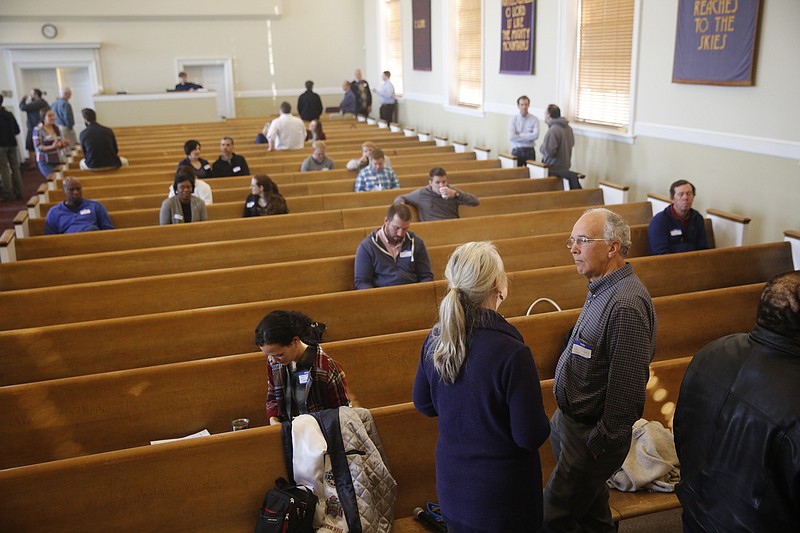When the national, anti-Trump media is fixed on convincing Americans a recession is just around the corner, positive economic news doesn't get much exposure.
So it's possible you may have missed the U.S. Census Bureau's report last week on poverty in 2018 falling to its lowest level in nearly two decades.
On this issue, then, it must be understood the president, who the national media tells us is doing everything he can to worsen the lives of the poor and minorities, has failed miserably in his task.
While the official poverty rate was 11.8%, which reflected 8 million fewer people in poverty than in 2014, it showed a rate of 2.3% when people worked full time and for a full year (hint, hint) and 4.7% for families headed by married couples (hint, hint).
And the president, who is reported to care nothing about the economic conditions for women, has fallen short in that capacity, too.
In 2018, for the first time, according to Census numbers, the country had more than 50 million full-time, full-year female workers, and median earnings for full-time, full-year female workers is up about 40% in real terms since the 1970s while the numbers for men over the same period are generally flat.
Now Republicans, for whom the numbers are good news, and Democrats, for whom the numbers are bad news when it comes to convincing Americans their conditions are getting worse, are going to spin the report differently.
For Republicans, poverty numbers don't mean everything's perfect for those who struggle economically but that things are improving. Democrats, needing to dig a little deeper, say fewer poor people now have health insurance (less than .7% fewer), women only earned 82 cents for every dollar a man earned (up 1.5% since 2017) and the poverty rate in the South didn't fall (rose by 1.7%).
But without getting too far into the weeds, we want to go behind the numbers a bit to explain both how the 2018 numbers are even better than they might seem and how "official poverty" doesn't explain as much as it used to.
Poverty, according to the federal government's Official Poverty Measure report, declined .5% from 2017 to 2018. The decline is notable because the rate only includes income before taxes and does not include noncash benefits provided by Medicare, Medicaid, SNAP (Supplementary Nutrition Assistance Program, the former food stamps), public housing and employer-provided fringe benefits.
It indicates, then, that more poor people worked in 2018 and worked for money than than they did in 2017. It further shows that, regardless of noncash benefits, enough poor people earned more money in 2018 to cause the official poverty rate to decline by half a percent.
The problem, according to the nonprofit, nonpartisan American Enterprise Institute, is that official poverty does not include the largest - and growing - government transfer programs and tax credits when determining an individual's income. That, in turn, makes it more difficult both to determine who is really poor and how well the programs are serving the actually poor.
And if 2020 Democratic presidential candidates have their way with specific proposals, the difference between official poverty and actual family resources would continue to widen.
For example, the LIFT the Middle Class Act sponsored by U.S. Sen. Kamala Harris, D-California, would create a new refundable tax credit of up to $3,000 per person or $6,000 for married couples filing jointly, much of which would go to low-income families. Its benefit would not be counted toward the official poverty measure.
The Universal Child Care and Early Learning Act, sponsored by U.S. Sen. Elizabeth Warren, D-Massachusetts, would widely expand federal support for child care, including making it free for families below 200% of the poverty line. Once more, a high percentage of the benefits would go to low-income families but not be counted on the official poverty measure.
Those are just a few of the suggested programs that would not count in assessing actual poverty.
In other words, a working family with only poverty wages (see above - not likely) might have to pay nothing for or be highly subsidized in paying for food, housing, health care and child care, and could get a slew of tax credits, but would be counted as "in poverty" simply from what they earn in wages (plus Supplemental Social Security and Temporary Assistance for Needy Families).
The Census Bureau in 2011 created a Supplemental Poverty Measure - using some of the additional benefits - in an attempt to get at a more accurate look at poverty, but it also has its critics and suffers from underreporting. Other efforts, such as the 2007 Poverty Measurement Improvement Act, were promising but were not passed.
For political purposes, one U.S. party wants to keep the poverty level high, and another desires to keep it low. So a more accurate measure may not be on the horizon. In the meantime, Americans should be gratified poverty - at least officially - is declining.
